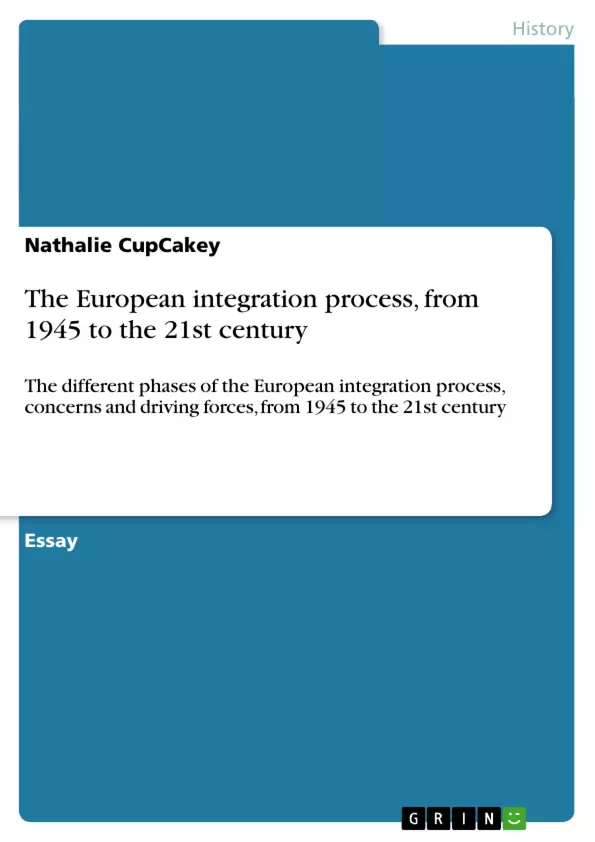The Second World War was an utterly brutal episode in the history of Europe which would leave its marks for the next half century that followed. It had altered the ethnic structure of Europe through population movements and mass murder, transforming pre-war Europe into a completely different continent. In 1945 the European countries were weakened and divided by two super-powers, the USA on the Western side, and the USSR in the East. In the following decades Europe will slowly regain confidence: the experienced defeat of war brought many countries to place their hope in a unified Europe in which civil wars like the previous two would become impossible. The wish to pacify the continent gained in strength and this was the backdrop for the idea of forming a European Community.
This paper will demonstrate through chronological phases how the integration process of the EU took place, while focusing on the various driving forces/actors that spurred the community's growth, without forgetting to look at the different concerns that darkened the bright horizon of the Union.
From 1945 to 1959: Common strife towards pacifism and beginnings of cooperation
With the common aim of ending the frequent and bloody wars that have shattered most european countries and which were at its highest during the Second World War (1939-1945), the European Union seemed like a bright and promising project, even if European leaders were facing heavy challenges: since the Yalta summit in 1945, Europe was divided between the United States and the USSR, both retaining control over the Western and the Eastern part of the continent respectively. This brought about several conditions and changes for the European countries: they were bound to be dominated by the US economically as well as militarily, the loss of their status as a 'Great Power' was very painful especially for Britain and France who also gradually lost most of their colonies. In spite of a certain number of draw-backs, the US tutelage also had its good points. In the year 1947 for instance, the Marshall Plan was set up by the US in order to help Europe recover after the war. This strategy was also meant to encourage cooperation between the recipient nation, and that was very important so as to bond the two bitter enemies, France and Germany, and avoid another outbreak of violence in the future (Warleigh, 2004).
Inhaltsverzeichnis (Table of Contents)
- From 1945 to 1959: Common strife towards pacifism and beginnings of cooperation
- The development and limits of integration in the 1960s and 1970s
- The mid-1980s: “Single Market” & “Single Act”
- The late 1980s: the rocky road to Maastricht
Zielsetzung und Themenschwerpunkte (Objectives and Key Themes)
This paper aims to chronologically demonstrate the integration process of the EU, highlighting the driving forces and actors that propelled its growth. The paper also examines concerns and challenges that emerged during the development of the European Union.
- The historical context of post-World War II Europe and the desire for a unified continent to prevent future wars.
- The role of key figures and their contributions to European integration, including Winston Churchill, Robert Schuman, Jean Monnet, Charles de Gaulle, and Jacques Delors.
- The evolution of the integration process, from the initial focus on economic cooperation to the establishment of a political union.
- The challenges and obstacles to integration, such as the economic crises, national sovereignty concerns, and the rise of Euroscepticism.
- The significance of the Treaty of Maastricht and its impact on the development of the European Union.
Zusammenfassung der Kapitel (Chapter Summaries)
The first chapter focuses on the initial stages of European integration, emphasizing the common desire for peace and the creation of the European Coal and Steel Community (ECSC) as a means to prevent future wars. It explores the key role of Winston Churchill and the Schuman Declaration in laying the foundation for European cooperation.
The second chapter examines the European integration process in the 1960s and 1970s. It highlights the challenges posed by Charles de Gaulle's vision for a more intergovernmental approach to European integration and the economic crises that impacted the continent.
The third chapter discusses the mid-1980s, a period marked by the “Single Market” initiative and the Single European Act (SEA). It explores the role of neoliberalism, the influence of West-European companies, and the resurgence of momentum toward greater integration.
The fourth chapter delves into the events leading up to the Treaty of Maastricht, including the fall of the Berlin Wall, the resurgence of Germany, and the growing desire for deeper political integration within the European Union. It emphasizes the significance of the Treaty of Maastricht as a turning point in the history of Europe.
Schlüsselwörter (Keywords)
The main keywords and focus topics of this paper include: European integration, European Union, post-World War II Europe, pacifism, economic cooperation, political union, driving forces, actors, concerns, challenges, Treaty of Rome, Treaty of Maastricht, Economic and Monetary Union, Euroscepticism.
- Arbeit zitieren
- Nathalie CupCakey (Autor:in), 2012, The European integration process, from 1945 to the 21st century, München, GRIN Verlag, https://www.hausarbeiten.de/document/212389


